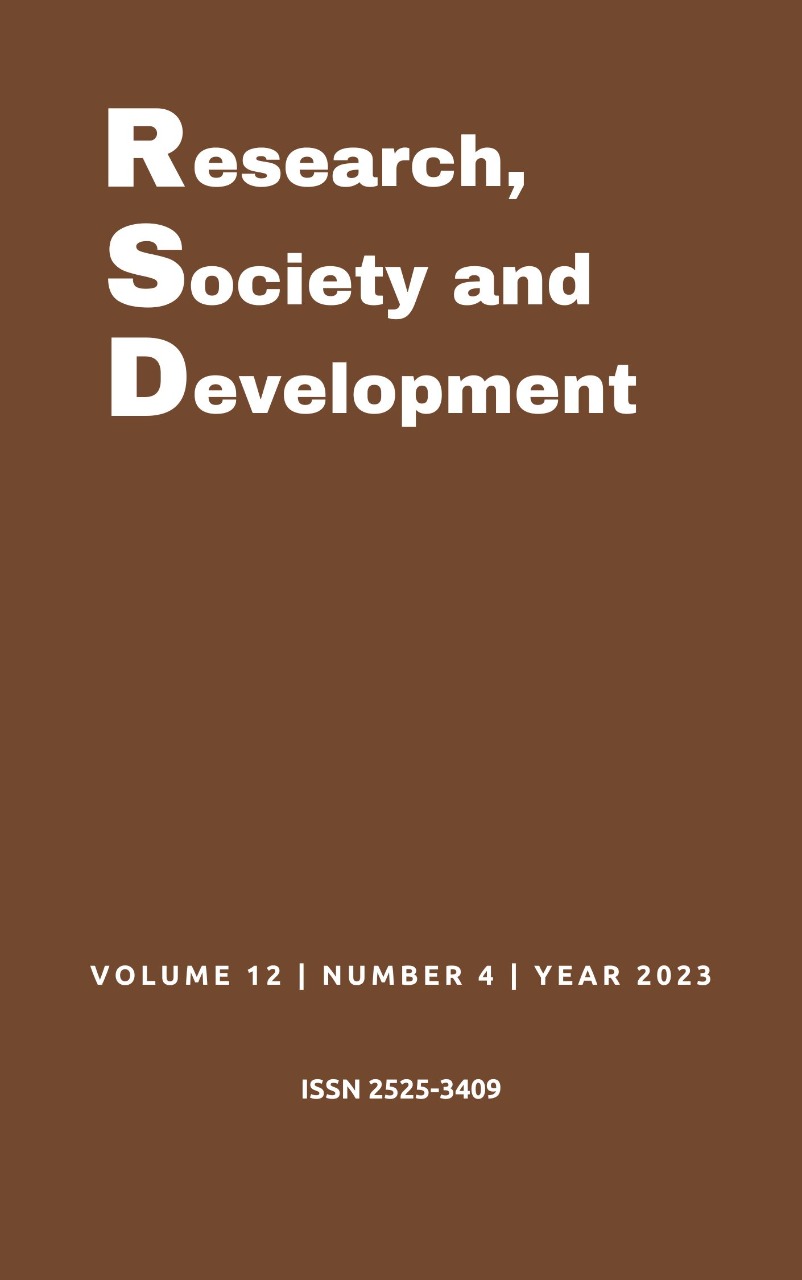Instrumentação mecanizada dos canais radiculares: uma revisão de literatura
DOI:
https://doi.org/10.33448/rsd-v12i4.40916Palavras-chave:
Endodontia, Tratamento do canal radicular, Preparo de canal radicular.Resumo
A Endodontia vem passando por avanços tecnológicos e melhorias clínicas, com tratamentos cada vez mais rápidos e eficazes. A técnica mecanizada nos preparos dos canais radiculares, reduziu os erros operatórios, aumentando o sucesso clínico do tratamento endodôntico. O objetivo deste trabalho consiste em realizar uma revisão de literatura nas bases de dados como Scielo, BVS, Google Scholar, PubMed e alguns livros, no período entre 2012 e 2022, sobre a instrumentação mecanizada no tratamento endodôntico, bem como discutir suas vantagens e desvantagens na Endodontia. A partir dos achados dessa revisão, observa-se a importância dos instrumentos mecanizados para a Endodontia, tanto no cotidiano do cirurgião-dentista, como promovendo melhorias na qualidade e previsibilidade da preparação dos canais radiculares, em contraste aos convencionais. No entanto, mais estudos são necessários, pois cada instrumento apresenta suas indicações e limitações.
Referências
Cunha, A. D. (2016). Sistemas endodônticos de rotação contínua x sistemas rotatórios alternados: Revisão de literatura (Trabalho de Conclusão de Curso de Graduação em Odontologia). Universidade Tiradentes, Aracajú, SE.
Freitas, C. B. V., Garcia, V. B., Fernandes, K. G. C., Boer, N. C. P., & Moreti, L. C. T. (2018). Sistemas endodônticos rotatórios contínuos x reciprocantes: revisão de literatura. Archives of Health Investigation, 7.
Keskin, C., Inan, U., Demiral, M., & Keleş, A. (2017). Cyclic fatigue resistance of Reciproc Blue, Reciproc, and WaveOne Gold reciprocating instruments. Journal of Endodontics, 43(8), 1360-1363.
Kuzekanani, M. (2018). Nickel–Titanium rotary instruments: Development of the single-file systems. Journal of International Society of Preventive & Community Dentistry, 8(5), 386.
Lakatos, E. M., & Marconi, M. D. A. (2007). Fundamentos de metodologia científica. 5. reimp. Atlas, 310.
Lopes, H. P., & Siqueira Jr, J. F. (2020). Endodontia: Biologia e técnica (5th ed.). Rio de Janeiro: Elsevier.
Martins, D. A., Vieira, E. A. A., & Kervahal, P. A. (2022). Benefícios das limas rotatórias no tratamento Endodontia. Research, Society and Development, 11(13), e595111335957-e595111335957.
Morais, S. J., Duarte, P. H. M., & Junior, N. B. D. (2022). O uso de sistemas mecanizados em endodontia na graduação. Anais da Mostra de Iniciação Científica do Cesuca-ISSN 2317-5915, 16, 749-749.
Moreira, S. H. H. C., de Castro, F. T. L., Diógenes, M. A. R., & Lima, D. M. (2018). Defeitos dentinários após instrumentação mecanizada: Revisão de literatura. Jornada Odontológica dos Acadêmicos da Católica, 4(1).
Mozardo, D. S. B., Hussne, R. P., Nishiyama, C. K., Bodanezi, A., & Câmara, A. S. (2014). Efetividade de um sistema rotatório para retratamento na remoção da obturação de canais radiculares. Revista da Associacao Paulista de Cirurgioes Dentistas, 68(3), 202-207.
Okabashi, S. (2015). Análise das vantagens e desvantagens dos sistemas rotatórios contínuos e reciprocantes nos tratamentos endodônticos: Revisão de literatura. https://openrit.grupotiradentes.com.
Ramos, A. M. A. (2021). Endodontia mecanizada: sistemas rotatórios e reciprocantes. Recuperado de https://openrit.grupotiradentes.com/ [Accessed 1 May 2021].
Schäfer, E., & Bürklein, S. (2012). Impact of nickel–titanium instrumentation of the root canal on clinical outcomes: A focused review. Odontology, 100, 130-136.10.1007/s10266-011-0025-9
Siddique, R., & Nivedhitha, M. S. (2019). Effectiveness of rotary and reciprocating systems on microbial reduction: A systematic review. Journal of Conservative Dentistry: JCD, 22(2), 114.
Silva, E., de Lima, C. O., Vieira, V., Antunes, H., Moreira, E. J. L., & Versiani, M. (2020). Cyclic fatigue and torsional resistance of four martensite-based nickel titanium reciprocating instruments. European Endodontic Journal, 5(3), 231. https://doi.org/10.1016/j.eje.2020.04.004.
Sousa, L. F. M. (2019). Evolução da composição das ligas metálicas utilizadas em endodontia mecanizada: da liga de aço inoxidável à liga M-Wire (Tese de Doutorado). Recuperado de http://hdl.handle.net/10316/74753.
Souza, J. P., de Oliveira, L. K. L., de Araújo, W. R., & Lopes, L. P. B. (2020). Instrumentação endodontica mecanizada e suas evoluções: Revisão de literatura. Brazilian Journal of Development, 6(12), 96231-96240.
Tavares, W. L. F., Mayor, C. D. P. S., de Souza Gonçalves, G., Viana, A. C. D., & Henriques, L. C. F. (2015). Índice de fratura de instrumentos manuais de aço inoxidável e rotatórios de NiTi em clínica de pós-graduação em Endodontia. Arquivos em Odontologia, 51(3), 245-250.
Zuolo, M. L., Kherlakian, D., Junior, J. E. M., Carvalho, M. C. C., & Fagundes, M. (2017). Reintervenção em Endodontia. Rio de Janeiro: Quintessence Editora.
Zupanc, J., Vahdat-Pajouh, N., & Schäfer, E. (2018). New thermomechanically treated NiTi alloys–a review. International Endodontic Journal, 51(10), 1088-1103.10.1111/iej.12999.
Downloads
Publicado
Edição
Seção
Licença
Copyright (c) 2023 Lucas Laerte Ribeiro dos Santos; Jaciara Alves Busarello; Elton de Lima Rodrigues

Este trabalho está licenciado sob uma licença Creative Commons Attribution 4.0 International License.
Autores que publicam nesta revista concordam com os seguintes termos:
1) Autores mantém os direitos autorais e concedem à revista o direito de primeira publicação, com o trabalho simultaneamente licenciado sob a Licença Creative Commons Attribution que permite o compartilhamento do trabalho com reconhecimento da autoria e publicação inicial nesta revista.
2) Autores têm autorização para assumir contratos adicionais separadamente, para distribuição não-exclusiva da versão do trabalho publicada nesta revista (ex.: publicar em repositório institucional ou como capítulo de livro), com reconhecimento de autoria e publicação inicial nesta revista.
3) Autores têm permissão e são estimulados a publicar e distribuir seu trabalho online (ex.: em repositórios institucionais ou na sua página pessoal) a qualquer ponto antes ou durante o processo editorial, já que isso pode gerar alterações produtivas, bem como aumentar o impacto e a citação do trabalho publicado.


